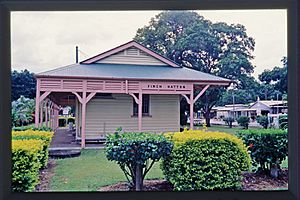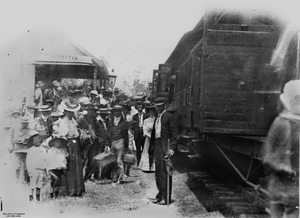Finch Hatton railway station facts for kids
Quick facts for kids Finch Hatton railway station |
|
|---|---|

Finch Hatton railway station
|
|
| Location | Mackay-Eungella Road, Finch Hatton, Mackay Region, Queensland, Australia |
| Design period | 1900 - 1914 (early 20th century) |
| Built | 1904 |
| Architectural style(s) | Classicism |
| Official name: Finch Hatton Railway Station, Hattton Railway Station, Pelion Railway Station | |
| Type | state heritage (built) |
| Designated | 6 December 2004 |
| Reference no. | 600985 |
| Significant period | 1904-1990 (historical) |
| Significant components | railway station, views to |
| Lua error in Module:Location_map at line 420: attempt to index field 'wikibase' (a nil value). | |
The Finch Hatton railway station is a historic former train station located on Mackay-Eungella Road in Finch Hatton, Queensland, Australia. It was built in 1904. This station was also known as Hatton railway station and Pelion railway station at different times. It is now listed on the Queensland Heritage Register because of its important history.
Contents
History of the Finch Hatton Railway Station
The Finch Hatton railway station first opened on 21 September 1904. It was part of the Pioneer Valley Line, which was a section of the larger Mackay Railway. The first part of this railway opened on 10 August 1885, ending at Mirani.
Early Settlement in Pioneer Valley
In 1860, John Mackay and his group explored and named the valley of the Mackay River. This river was later renamed the Pioneer River in 1862. The next year, Mackay returned to start a cattle station. Other settlers soon followed. In 1862, a small ship called "Presto" brought supplies and building materials into the Mackay River. The river mouth was then officially made a Port of Entry, meaning ships could legally enter and trade there.
Before the railway, the Pioneer Valley area was mostly used for two large cattle farms called Hamilton and Hopetoun. The town now known as Mirani was originally called Hamilton. Its name was changed to Mirani to avoid confusion with the suburb of Hamilton in Brisbane.
The Need for Railways
Sugar cane is a heavy crop that needs to be processed quickly after it's harvested. In the 1800s, trains were the best way to move sugar cane fast enough. Because of this, every sugar farming area built its own network of small railways and tramways. These were built by sugar mills, local councils, and the Queensland Government.
The first sugar mill in the area, Alexandra, started in 1868. People began asking for a local railway network in the late 1870s. Independent cane growers especially wanted a government-run railway. This would allow them to choose which mill crushed their cane, instead of being forced to use the closest one.
Building the Pioneer Valley Line
The plan for the Pioneer Valley line was approved by the government in October 1882. Mackay was becoming a well-known center for sugar. Some private sugar mills, like the Colonial Sugar Refining Company, already had their own small steam tramways. For example, John Spiller built a five-kilometer line on his River Estate farm in 1880.
Construction of the railway line began in late 1883. It ran west from Mackay, following the south bank of the river towards Mirani. The first part of the line, from Mackay to Mirani, opened on 10 August 1885. A branch line also ran south from Newbury Junction towards Eton, another important settlement.
Extending the Railway West
In 1885, Mirani was the end of the railway line. However, people wanted the line extended further west to open up more land for growing sugar cane. Farmers were settling west of Mirani, but the Pioneer River had no bridge, making transport difficult.
A short extension of the line was built over the Pioneer River at Mirani in 1897. This included a bridge with five steel sections. The two kilometers of track to Mirani West officially opened on 11 December 1897.
Plans for a bigger extension of the Pioneer Railway line were presented to the government in 1900. The line was extended further west to Pinnacle, opening on 7 July 1902. This was the first line built using a new "day labour" system, where the government hired workers directly instead of using contractors.
The Pioneer Valley line was very important for the sugar industry. It allowed much more land to be used for sugar cane farming. It also helped create a system where cane could be sent to central mills, and it offered a different way to transport goods besides shipping. This meant cane farms could be located away from major waterways.
Finch Hatton Becomes a Terminus
Even after the railway reached Pinnacle in 1902, there was still good farming land many kilometers beyond. The Racecourse Central Sugar Company wanted to expand cane growing in the Upper Pioneer Valley. The Sugar Company, the Pioneer Shire Council, and local farmers worked together to turn this area into a productive sugar district. Extending the railway line to Finch Hatton was key to this plan.
Soon after the line reached Pinnacle, people asked the government to extend it even further. Since the government had other priorities, the Pioneer Shire Council decided to build the next section to Finch Hatton themselves. The railway from Pinnacle to Finch Hatton opened on 21 September 1904. Finch Hatton then became the end of the Pioneer Valley line. This led to more people settling in the area and the creation of the Finch Hatton township.
In September 1904, a local newspaper reported that Hatton (as Finch Hatton was then called) was starting to look like a business area. A hotel had also been built. The railway extension helped open up more land for sugar cane, leading to the Cattle Creek mill opening south-east of Finch Hatton in 1906. In 1906, Hatton was renamed Pelion, but a few months later, the name was changed to Finch Hatton.
The government took over the Pinnacle-Finch Hatton railway section from 1 July 1910. They quickly built the extension west to Netherdale. By 1914, tourists started visiting the Eungella Range area. They would travel by train to Netherdale and then walk up the improved road to Eungella.
Life at the Station
Finch Hatton station had a station master in charge. They managed a lot of train traffic coming from and going to the nearby Cattle Creek mill, which had its own private railway siding. The station master worked long hours, and there was also a Night Officer, so the station was staffed for two shifts.
In 1913, Queensland Railways published a brochure called "Tours in the Mackay District." It highlighted the beautiful nature of the region, especially the Eungella Ranges. By the 1920s, Finch Hatton had become the largest town in the area, apart from Mackay and Sarina.
In 1932, a special group was formed to study the Eungella area. They looked at its potential for settlement, forestry, and tourism. They decided that the area's "primeval" (ancient) jungle should be protected. In 1941, the Eungella National Park was officially created because of the importance of the Eungella area.
Closure and Current Use
The Mackay Railway, from Kowari to Netherdale (west of Finch Hatton), officially closed on 19 December 1977 after being damaged by floods. The section of the railway between Marian and Finch Hatton, which included the Finch Hatton railway station, closed on 2 October 1990. The job of station master was ended in 1988. The Cattle Creek Mill also closed in 1990. This was common in sugar areas as changes in the industry led to less cane being grown and mills closing. Many train lines disappeared, and trucks were increasingly used to take the harvest to the mills.
By 1994, only the station building remained. The station master's house had been moved to another street in Finch Hatton.
The former station building was then taken over by the Mirani Shire Council. They now run the building as the Finch Hatton Historic Railway Station and Internet Access Centre. The center focuses on the local history and the development of the Pioneer Valley. Since 2015, the building has been owned and operated by the Mackay Regional Council.
Description of the Station Building
The former Finch Hatton Railway Station is a single-story building made of timber. It sits on low timber stumps and has timber weatherboards on its outside walls. The building has a gable roof on the eastern side and a gambrel roof on the western side, both covered with corrugated iron. Timber vents are high up on the western and eastern walls. The roof extends over the northern, southern, and side parts of the building, providing shade.
The building has decorative, carved wooden panels called spandrels running along the northern and southern sides. These are similar to those found at the Mirani railway station building. The station building also has timber louvred (slatted) panels along the western side with the station name boards.
Inside, from east to west, the building used to have a ladies' room and toilet, a shelter area, and an office.
The building is surrounded by well-kept gardens and old trees. There are also several special monuments called commemorative cairns on the property.
Why Finch Hatton Railway Station is Important
The former Finch Hatton Railway Station was added to the Queensland Heritage Register on 6 December 2004 because it meets certain important standards.
The place shows how Queensland's history developed. The Finch Hatton railway station building is important because it is a good example of a country branch line station that is still mostly in its original state. It shows how important Queensland's sugar industry railway networks were. It also shows how these networks slowly disappeared as the industry changed and trucks became the main way to transport cane. Located on the Pioneer Valley Line of the Mackay Railway, the Finch Hatton railway station building reminds us of how the area grew into a major cane-growing region in the late 1800s and early 1900s. The railway also helped the timber and tourism industries grow in the area.
The place shows the main features of its type. The Finch Hatton Railway Station building is a good example of a country branch line timber railway building. It used to have an office area and a shelter area with shade on both sides, and ticket windows facing the shelter areas. Its decorative carved wooden panels are similar to those at the Mirani railway station building.
The place is beautiful to look at. The Finch Hatton railway station building is important for its beauty. This is especially true because of its unique architectural features, its well-preserved condition, and its pretty location on the main street of the town, near the Finch Hatton War Memorial.


